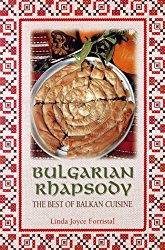
Bulgaria is a small Balkan country that gets little attention. On a visit in 1990, however, Linda Joyce Forristal fell in love with both the country and its food. In Bulgarian Rhapsody, she painstakingly presents Bulgarian cooking, placing emphasis on many of its full-flavored and colorful vegetarian dishes, though popular meat dishes are included as well. The Bulgarian kitchen is heavily influenced by Mediterranean cooking, not a surprise since the neighboring Turks occupied it for 500 years. Greece is also a neighbor, along with Romania and Yugoslavia. Bulgarians favor the slow cooking of stews and soups. They use fresh vegetables, particularly tomatoes, sweet red peppers, eggplant, zucchini, and potatoes. Stuffed grape leaves, phyllo pies, and mousaka--the Bulgarian spelling--will be familiar. Forristal offers a meatless mousaka made with zucchini and several kinds of plakiya, stews that are vibrant with tomatoes and onions, similar to dishes you find in Greek restaurants. The gyuveches are baked stews that resemble their Romanian counterparts. The typical meatless one made with string beans, tomatoes, eggplant, cabbage, potatoes, carrots, red and green bell peppers, and zucchini, resembles a ratatouille. The one made with sausages and red peppers is much simpler. If you enjoy discovering new dishes, tutmanik, a quickbread made with cheese, and Baked Peppers Stuffed with White Beans are alluring. The potato salad seasoned with oregano and paprika is also different from the usual. Do ignore one technique Forristal uses: peeling roasted peppers under running water washes away much of their flavor. Better to leave a few charred specks of skin than to do this. --Dana Jacobi